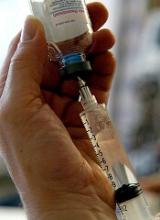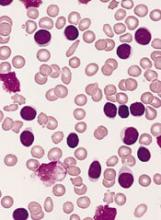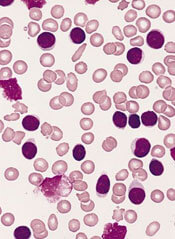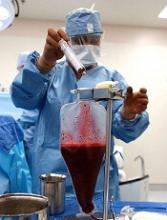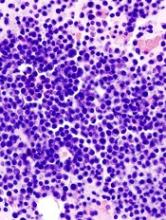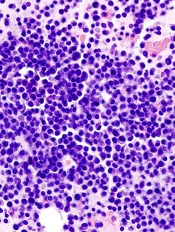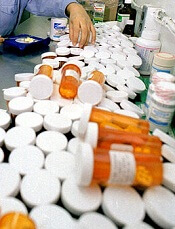User login
PRAC finds insufficient evidence of difference between FVIII products
There is no “clear and consistent evidence” that hemophilia A patients are more likely to develop inhibitors if they receive a recombinant factor VIII (FVIII) product rather than a plasma-derived FVIII product, according to the European Medicines Agency’s (EMA) Pharmacovigilance Risk Assessment Committee (PRAC).
The PRAC conducted a review of FVIII products to evaluate the risk of inhibitor development in patients with hemophilia A who had not previously received FVIII treatment.
The review covered all FVIII products authorized for use in the European Union. This includes products containing the active substances human coagulation factor VIII, efmoroctocog alfa, moroctocog alfa, octocog alfa, simoctocog alfa, susoctocog alfa, and turoctocog alfa.
The review was started after publication of the SIPPET study, which indicated that inhibitors occur more frequently in patients receiving FVIII products made by recombinant DNA technology rather than FVIII products derived from plasma.
The PRAC’s review also covered other relevant studies, including interventional clinical trials and observational studies.
The studies reviewed differed in their design, patient populations, and findings, and the PRAC concluded that they did not provide clear evidence of a difference in the risk of inhibitor development between the 2 classes of FVIII products.
In addition, due to the different characteristics of individual products within the 2 classes, the PRAC considered that evaluation of the risk of inhibitor development should be at the product level instead of at the class level.
The risk for each individual product will continue to be assessed as more evidence becomes available.
The PRAC recommended that prescribing information be updated to reflect the current evidence. The update should include, as appropriate, listing of the development of inhibitors as a very common side effect in previously untreated patients and as an uncommon side effect in previously treated patients.
The existing warning on inhibitor development should be amended to highlight that the presence of low levels of inhibitors poses less of a risk of severe bleeding than high levels.
The PRAC’s recommendation will be sent to the EMA’s Committee for Medicinal Products for Human Use (CHMP) for the adoption of the EMA’s final opinion. Further details and information for patients and healthcare professionals will be published at the time of the CHMP opinion.
The final stage of the review procedure is the adoption by the European Commission of a legally binding decision applicable in all European Union member states. ![]()
There is no “clear and consistent evidence” that hemophilia A patients are more likely to develop inhibitors if they receive a recombinant factor VIII (FVIII) product rather than a plasma-derived FVIII product, according to the European Medicines Agency’s (EMA) Pharmacovigilance Risk Assessment Committee (PRAC).
The PRAC conducted a review of FVIII products to evaluate the risk of inhibitor development in patients with hemophilia A who had not previously received FVIII treatment.
The review covered all FVIII products authorized for use in the European Union. This includes products containing the active substances human coagulation factor VIII, efmoroctocog alfa, moroctocog alfa, octocog alfa, simoctocog alfa, susoctocog alfa, and turoctocog alfa.
The review was started after publication of the SIPPET study, which indicated that inhibitors occur more frequently in patients receiving FVIII products made by recombinant DNA technology rather than FVIII products derived from plasma.
The PRAC’s review also covered other relevant studies, including interventional clinical trials and observational studies.
The studies reviewed differed in their design, patient populations, and findings, and the PRAC concluded that they did not provide clear evidence of a difference in the risk of inhibitor development between the 2 classes of FVIII products.
In addition, due to the different characteristics of individual products within the 2 classes, the PRAC considered that evaluation of the risk of inhibitor development should be at the product level instead of at the class level.
The risk for each individual product will continue to be assessed as more evidence becomes available.
The PRAC recommended that prescribing information be updated to reflect the current evidence. The update should include, as appropriate, listing of the development of inhibitors as a very common side effect in previously untreated patients and as an uncommon side effect in previously treated patients.
The existing warning on inhibitor development should be amended to highlight that the presence of low levels of inhibitors poses less of a risk of severe bleeding than high levels.
The PRAC’s recommendation will be sent to the EMA’s Committee for Medicinal Products for Human Use (CHMP) for the adoption of the EMA’s final opinion. Further details and information for patients and healthcare professionals will be published at the time of the CHMP opinion.
The final stage of the review procedure is the adoption by the European Commission of a legally binding decision applicable in all European Union member states. ![]()
There is no “clear and consistent evidence” that hemophilia A patients are more likely to develop inhibitors if they receive a recombinant factor VIII (FVIII) product rather than a plasma-derived FVIII product, according to the European Medicines Agency’s (EMA) Pharmacovigilance Risk Assessment Committee (PRAC).
The PRAC conducted a review of FVIII products to evaluate the risk of inhibitor development in patients with hemophilia A who had not previously received FVIII treatment.
The review covered all FVIII products authorized for use in the European Union. This includes products containing the active substances human coagulation factor VIII, efmoroctocog alfa, moroctocog alfa, octocog alfa, simoctocog alfa, susoctocog alfa, and turoctocog alfa.
The review was started after publication of the SIPPET study, which indicated that inhibitors occur more frequently in patients receiving FVIII products made by recombinant DNA technology rather than FVIII products derived from plasma.
The PRAC’s review also covered other relevant studies, including interventional clinical trials and observational studies.
The studies reviewed differed in their design, patient populations, and findings, and the PRAC concluded that they did not provide clear evidence of a difference in the risk of inhibitor development between the 2 classes of FVIII products.
In addition, due to the different characteristics of individual products within the 2 classes, the PRAC considered that evaluation of the risk of inhibitor development should be at the product level instead of at the class level.
The risk for each individual product will continue to be assessed as more evidence becomes available.
The PRAC recommended that prescribing information be updated to reflect the current evidence. The update should include, as appropriate, listing of the development of inhibitors as a very common side effect in previously untreated patients and as an uncommon side effect in previously treated patients.
The existing warning on inhibitor development should be amended to highlight that the presence of low levels of inhibitors poses less of a risk of severe bleeding than high levels.
The PRAC’s recommendation will be sent to the EMA’s Committee for Medicinal Products for Human Use (CHMP) for the adoption of the EMA’s final opinion. Further details and information for patients and healthcare professionals will be published at the time of the CHMP opinion.
The final stage of the review procedure is the adoption by the European Commission of a legally binding decision applicable in all European Union member states. ![]()
BTK inhibitor staves off progression in CLL
Long-term follow-up of a phase 1 study suggests the BTK inhibitor ONO/GS-4059 can stave off progression in patients with relapsed or refractory chronic lymphocytic leukemia (CLL).
Roughly 60% of the patients studied were progression-free and still taking ONO/GS-4059 at last follow-up, with the longest time on treatment exceeding 3 years.
In addition, researchers said the extended follow-up revealed no new safety concerns, and the maximum tolerated dose of ONO/GS-4059 has not been reached.
Martin Dyer, DPhil, of the University of Leicester in the UK, and his colleagues reported these results in Blood.
The research was funded by Gilead Sciences, Inc., and ONO Pharmaceuticals helped with data analysis.
The study enrolled 90 patients with relapsed or refractory B-cell malignancies, 28 of whom had CLL. Dr Dyer and his colleagues reported follow-up results in CLL patients only.
The patients’ median number of prior treatments was 4 (range, 2-9), and 11 patients were refractory to their last line of therapy. None had received prior treatment with a BTK inhibitor.
The patients received ONO/GS-4059 at varying doses, from 20 mg once daily (QD) to 600 mg QD and a twice-daily (BID) regimen of 300 mg. Six patients were also taking anticoagulant therapy while on study.
Patients were allowed to continue treatment with ONO/GS-4059 if they responded to the drug or maintained stable disease.
Initially, 25 patients were evaluable for response, and 24 of them responded to ONO/GS-4059, for an overall response rate of 96%.
At last follow-up on June 8, 2016, 17 patients were still receiving ONO/GS-4059, and all had a very good partial response.
Dr Dyer said the responses have been similar to those seen with other irreversible BTK inhibitors. Most have involved rapid and almost complete resolution of lymph node masses and rapid improvement in hematological indexes.
“It is clear . . . that the major responses occur rapidly, within the first 3 months of drug, and that, thereafter, improvement occurs at a much slower rate,” Dr Dyer said. “It will be of interest, I think, to look at the remaining patients on study to assess whether responses deepen with time on drug.”
The duration of treatment for these patients ranged from 302 days to 1160 days at last follow-up. They were receiving ONO/GS-4059 at doses ranging from 40 mg QD to 600 mg QD or 300 mg BID, and no maximum tolerated dose had been identified.
Eleven patients (39.3%) discontinued ONO/GS-4059 due to death (n=3), disease progression (n=4), adverse events (AEs, n=3), and sponsor decision due to extended drug interruption (n=1). One of the patients included in the AE group also had concurrent disease progression.
The median progression-free survival was 38.5 months, and the median overall survival was 44.9 months. The median time on study was 32.5 months.
The most common treatment-emergent AEs were bruising (35.7%), neutropenia (35.7%), anemia (32.1%), nasopharyngitis (32.1%), fall (32.1%), cough (28.6%), arthralgia (28.6%), and basal cell carcinoma (28.6%).
The most common grade 3/4 AEs included neutropenia (25%), thrombocytopenia (14.3%), lower respiratory tract infection (14.3%), and anemia (10.7%).
“Our long-term follow-up shows maintained efficacy without toxicity,” Dr Dyer said. “This study is the first report of long-term follow-up of a selective BTK inhibitor, and it is excellent news for patients. We are now doing studies of ONO/GS-4059 in combination with other precision medicines to assess whether these results can be enhanced in patients with CLL and other B-cell malignancies.” ![]()
Long-term follow-up of a phase 1 study suggests the BTK inhibitor ONO/GS-4059 can stave off progression in patients with relapsed or refractory chronic lymphocytic leukemia (CLL).
Roughly 60% of the patients studied were progression-free and still taking ONO/GS-4059 at last follow-up, with the longest time on treatment exceeding 3 years.
In addition, researchers said the extended follow-up revealed no new safety concerns, and the maximum tolerated dose of ONO/GS-4059 has not been reached.
Martin Dyer, DPhil, of the University of Leicester in the UK, and his colleagues reported these results in Blood.
The research was funded by Gilead Sciences, Inc., and ONO Pharmaceuticals helped with data analysis.
The study enrolled 90 patients with relapsed or refractory B-cell malignancies, 28 of whom had CLL. Dr Dyer and his colleagues reported follow-up results in CLL patients only.
The patients’ median number of prior treatments was 4 (range, 2-9), and 11 patients were refractory to their last line of therapy. None had received prior treatment with a BTK inhibitor.
The patients received ONO/GS-4059 at varying doses, from 20 mg once daily (QD) to 600 mg QD and a twice-daily (BID) regimen of 300 mg. Six patients were also taking anticoagulant therapy while on study.
Patients were allowed to continue treatment with ONO/GS-4059 if they responded to the drug or maintained stable disease.
Initially, 25 patients were evaluable for response, and 24 of them responded to ONO/GS-4059, for an overall response rate of 96%.
At last follow-up on June 8, 2016, 17 patients were still receiving ONO/GS-4059, and all had a very good partial response.
Dr Dyer said the responses have been similar to those seen with other irreversible BTK inhibitors. Most have involved rapid and almost complete resolution of lymph node masses and rapid improvement in hematological indexes.
“It is clear . . . that the major responses occur rapidly, within the first 3 months of drug, and that, thereafter, improvement occurs at a much slower rate,” Dr Dyer said. “It will be of interest, I think, to look at the remaining patients on study to assess whether responses deepen with time on drug.”
The duration of treatment for these patients ranged from 302 days to 1160 days at last follow-up. They were receiving ONO/GS-4059 at doses ranging from 40 mg QD to 600 mg QD or 300 mg BID, and no maximum tolerated dose had been identified.
Eleven patients (39.3%) discontinued ONO/GS-4059 due to death (n=3), disease progression (n=4), adverse events (AEs, n=3), and sponsor decision due to extended drug interruption (n=1). One of the patients included in the AE group also had concurrent disease progression.
The median progression-free survival was 38.5 months, and the median overall survival was 44.9 months. The median time on study was 32.5 months.
The most common treatment-emergent AEs were bruising (35.7%), neutropenia (35.7%), anemia (32.1%), nasopharyngitis (32.1%), fall (32.1%), cough (28.6%), arthralgia (28.6%), and basal cell carcinoma (28.6%).
The most common grade 3/4 AEs included neutropenia (25%), thrombocytopenia (14.3%), lower respiratory tract infection (14.3%), and anemia (10.7%).
“Our long-term follow-up shows maintained efficacy without toxicity,” Dr Dyer said. “This study is the first report of long-term follow-up of a selective BTK inhibitor, and it is excellent news for patients. We are now doing studies of ONO/GS-4059 in combination with other precision medicines to assess whether these results can be enhanced in patients with CLL and other B-cell malignancies.” ![]()
Long-term follow-up of a phase 1 study suggests the BTK inhibitor ONO/GS-4059 can stave off progression in patients with relapsed or refractory chronic lymphocytic leukemia (CLL).
Roughly 60% of the patients studied were progression-free and still taking ONO/GS-4059 at last follow-up, with the longest time on treatment exceeding 3 years.
In addition, researchers said the extended follow-up revealed no new safety concerns, and the maximum tolerated dose of ONO/GS-4059 has not been reached.
Martin Dyer, DPhil, of the University of Leicester in the UK, and his colleagues reported these results in Blood.
The research was funded by Gilead Sciences, Inc., and ONO Pharmaceuticals helped with data analysis.
The study enrolled 90 patients with relapsed or refractory B-cell malignancies, 28 of whom had CLL. Dr Dyer and his colleagues reported follow-up results in CLL patients only.
The patients’ median number of prior treatments was 4 (range, 2-9), and 11 patients were refractory to their last line of therapy. None had received prior treatment with a BTK inhibitor.
The patients received ONO/GS-4059 at varying doses, from 20 mg once daily (QD) to 600 mg QD and a twice-daily (BID) regimen of 300 mg. Six patients were also taking anticoagulant therapy while on study.
Patients were allowed to continue treatment with ONO/GS-4059 if they responded to the drug or maintained stable disease.
Initially, 25 patients were evaluable for response, and 24 of them responded to ONO/GS-4059, for an overall response rate of 96%.
At last follow-up on June 8, 2016, 17 patients were still receiving ONO/GS-4059, and all had a very good partial response.
Dr Dyer said the responses have been similar to those seen with other irreversible BTK inhibitors. Most have involved rapid and almost complete resolution of lymph node masses and rapid improvement in hematological indexes.
“It is clear . . . that the major responses occur rapidly, within the first 3 months of drug, and that, thereafter, improvement occurs at a much slower rate,” Dr Dyer said. “It will be of interest, I think, to look at the remaining patients on study to assess whether responses deepen with time on drug.”
The duration of treatment for these patients ranged from 302 days to 1160 days at last follow-up. They were receiving ONO/GS-4059 at doses ranging from 40 mg QD to 600 mg QD or 300 mg BID, and no maximum tolerated dose had been identified.
Eleven patients (39.3%) discontinued ONO/GS-4059 due to death (n=3), disease progression (n=4), adverse events (AEs, n=3), and sponsor decision due to extended drug interruption (n=1). One of the patients included in the AE group also had concurrent disease progression.
The median progression-free survival was 38.5 months, and the median overall survival was 44.9 months. The median time on study was 32.5 months.
The most common treatment-emergent AEs were bruising (35.7%), neutropenia (35.7%), anemia (32.1%), nasopharyngitis (32.1%), fall (32.1%), cough (28.6%), arthralgia (28.6%), and basal cell carcinoma (28.6%).
The most common grade 3/4 AEs included neutropenia (25%), thrombocytopenia (14.3%), lower respiratory tract infection (14.3%), and anemia (10.7%).
“Our long-term follow-up shows maintained efficacy without toxicity,” Dr Dyer said. “This study is the first report of long-term follow-up of a selective BTK inhibitor, and it is excellent news for patients. We are now doing studies of ONO/GS-4059 in combination with other precision medicines to assess whether these results can be enhanced in patients with CLL and other B-cell malignancies.” ![]()
Study shows similar outcomes with RIC and MAC in MDS
Results of a phase 3 trial revealed similar outcomes in patients who underwent allogeneic hematopoietic stem cell transplant (HSCT) to treat myelodysplastic syndromes (MDS), regardless of the conditioning regimen they received.
Rates of engraftment, graft-vs-host disease (GVHD), relapse, and survival were similar between patients who received reduced-intensity conditioning (RIC) and those who received standard myeloablative conditioning (MAC) before HSCT.
Researchers reported these results in the Journal of Clinical Oncology.
“Our study shed new light on expected benefits of a reduced-intensity conditioning regimen that can be offered as a curative treatment approach, especially in older patients with MDS,” said study author Nicolaus Kröger, MD, of University Hospital Eppendorf in Hamburg, Germany.
Patient characteristics
The study, known as RICMAC, involved 129 patients who underwent HSCT between May 2004 and December 2012 at 18 transplant units in 7 countries.
Patients were randomized in a 1:1 ratio to RIC (n=65) or MAC (n=64) and were stratified according to donor type, age, and blast count.
The median age was 50 (range, 19-64) in the MAC arm and 51 (range, 22-63) in the RIC arm. The median blast percentage was 4% (range, 0-18) and 5% (range, 0-18), respectively.
According to IPSS, most patients in both arms had intermediate-I-risk disease (28 MAC, 25 RIC) or intermediate-II-risk disease (18 MAC, 24 RIC).
Similar numbers of patients in each arm had low cytogenetic risk (24 MAC, 28 RIC), intermediate cytogenetic risk (17 MAC, 13 RIC), and high cytogenetic risk (17 MAC, 18 RIC).
Thirty-three patients in the MAC arm and 32 in the RIC arm received ATG as GVHD prophylaxis.
Patients received grafts from matched related donors (17 MAC, 16 RIC), matched unrelated donors (36 MAC, 38 RIC), or mismatched related/unrelated donors (11 in both arms).
Most patients received peripheral blood stem cell grafts—61 in the MAC arm and 59 in the RIC arm.
Results
The researchers said engraftment was comparable between the arms. There were 4 graft failures in the MAC arm and 3 in the RIC arm (P=0.72). The median time to leukocyte engraftment was 15 days in both arms. The median time to platelet engraftment was 15 days in the RIC arm and 16 in the MAC arm (P=0.33).
There was no significant difference in the cumulative incidence of GVHD between the RIC and MAC arms:
- Grade 2-4 acute GVHD—32.3% and 37.5%, respectively
- Grade 3-4 acute GVHD—15% and 14%, respectively (P=0.35 for between-arm difference for all acute GVHD)
- Chronic GVHD—61.6% and 64.7%, respectively (P=0.76).
Though the occurrence of infection was similar between the MAC and RIC arms (48 and 44, respectively), the rate of infection was higher in the MAC arm than the RIC arm.
The rate of infection in the first 100 days was 6.9 per 100 person-years in the MAC arm and 4.3 in the RIC arm (P=0.002). The rate of infection during the total follow-up was 2.0 per 100 person-years in the MAC arm and 1.4 in the RIC arm (P=0.002).
There was no significant difference between the RIC and MAC arms with regard to the cumulative incidence of nonrelapse mortality after 1 year—16.9% and 25.3%, respectively (P=0.29).
And there was no significant difference in the cumulative incidence of relapse at 2 years—17% and 14.8%, respectively (P=0.6).
The 2-year relapse-free survival rate was similar in the MAC and RIC arms—58.3% and 62.4% (P=0.58)—as was the 2-year overall survival rate—63.2% and 76.3%, respectively (P=0.08). ![]()
Results of a phase 3 trial revealed similar outcomes in patients who underwent allogeneic hematopoietic stem cell transplant (HSCT) to treat myelodysplastic syndromes (MDS), regardless of the conditioning regimen they received.
Rates of engraftment, graft-vs-host disease (GVHD), relapse, and survival were similar between patients who received reduced-intensity conditioning (RIC) and those who received standard myeloablative conditioning (MAC) before HSCT.
Researchers reported these results in the Journal of Clinical Oncology.
“Our study shed new light on expected benefits of a reduced-intensity conditioning regimen that can be offered as a curative treatment approach, especially in older patients with MDS,” said study author Nicolaus Kröger, MD, of University Hospital Eppendorf in Hamburg, Germany.
Patient characteristics
The study, known as RICMAC, involved 129 patients who underwent HSCT between May 2004 and December 2012 at 18 transplant units in 7 countries.
Patients were randomized in a 1:1 ratio to RIC (n=65) or MAC (n=64) and were stratified according to donor type, age, and blast count.
The median age was 50 (range, 19-64) in the MAC arm and 51 (range, 22-63) in the RIC arm. The median blast percentage was 4% (range, 0-18) and 5% (range, 0-18), respectively.
According to IPSS, most patients in both arms had intermediate-I-risk disease (28 MAC, 25 RIC) or intermediate-II-risk disease (18 MAC, 24 RIC).
Similar numbers of patients in each arm had low cytogenetic risk (24 MAC, 28 RIC), intermediate cytogenetic risk (17 MAC, 13 RIC), and high cytogenetic risk (17 MAC, 18 RIC).
Thirty-three patients in the MAC arm and 32 in the RIC arm received ATG as GVHD prophylaxis.
Patients received grafts from matched related donors (17 MAC, 16 RIC), matched unrelated donors (36 MAC, 38 RIC), or mismatched related/unrelated donors (11 in both arms).
Most patients received peripheral blood stem cell grafts—61 in the MAC arm and 59 in the RIC arm.
Results
The researchers said engraftment was comparable between the arms. There were 4 graft failures in the MAC arm and 3 in the RIC arm (P=0.72). The median time to leukocyte engraftment was 15 days in both arms. The median time to platelet engraftment was 15 days in the RIC arm and 16 in the MAC arm (P=0.33).
There was no significant difference in the cumulative incidence of GVHD between the RIC and MAC arms:
- Grade 2-4 acute GVHD—32.3% and 37.5%, respectively
- Grade 3-4 acute GVHD—15% and 14%, respectively (P=0.35 for between-arm difference for all acute GVHD)
- Chronic GVHD—61.6% and 64.7%, respectively (P=0.76).
Though the occurrence of infection was similar between the MAC and RIC arms (48 and 44, respectively), the rate of infection was higher in the MAC arm than the RIC arm.
The rate of infection in the first 100 days was 6.9 per 100 person-years in the MAC arm and 4.3 in the RIC arm (P=0.002). The rate of infection during the total follow-up was 2.0 per 100 person-years in the MAC arm and 1.4 in the RIC arm (P=0.002).
There was no significant difference between the RIC and MAC arms with regard to the cumulative incidence of nonrelapse mortality after 1 year—16.9% and 25.3%, respectively (P=0.29).
And there was no significant difference in the cumulative incidence of relapse at 2 years—17% and 14.8%, respectively (P=0.6).
The 2-year relapse-free survival rate was similar in the MAC and RIC arms—58.3% and 62.4% (P=0.58)—as was the 2-year overall survival rate—63.2% and 76.3%, respectively (P=0.08). ![]()
Results of a phase 3 trial revealed similar outcomes in patients who underwent allogeneic hematopoietic stem cell transplant (HSCT) to treat myelodysplastic syndromes (MDS), regardless of the conditioning regimen they received.
Rates of engraftment, graft-vs-host disease (GVHD), relapse, and survival were similar between patients who received reduced-intensity conditioning (RIC) and those who received standard myeloablative conditioning (MAC) before HSCT.
Researchers reported these results in the Journal of Clinical Oncology.
“Our study shed new light on expected benefits of a reduced-intensity conditioning regimen that can be offered as a curative treatment approach, especially in older patients with MDS,” said study author Nicolaus Kröger, MD, of University Hospital Eppendorf in Hamburg, Germany.
Patient characteristics
The study, known as RICMAC, involved 129 patients who underwent HSCT between May 2004 and December 2012 at 18 transplant units in 7 countries.
Patients were randomized in a 1:1 ratio to RIC (n=65) or MAC (n=64) and were stratified according to donor type, age, and blast count.
The median age was 50 (range, 19-64) in the MAC arm and 51 (range, 22-63) in the RIC arm. The median blast percentage was 4% (range, 0-18) and 5% (range, 0-18), respectively.
According to IPSS, most patients in both arms had intermediate-I-risk disease (28 MAC, 25 RIC) or intermediate-II-risk disease (18 MAC, 24 RIC).
Similar numbers of patients in each arm had low cytogenetic risk (24 MAC, 28 RIC), intermediate cytogenetic risk (17 MAC, 13 RIC), and high cytogenetic risk (17 MAC, 18 RIC).
Thirty-three patients in the MAC arm and 32 in the RIC arm received ATG as GVHD prophylaxis.
Patients received grafts from matched related donors (17 MAC, 16 RIC), matched unrelated donors (36 MAC, 38 RIC), or mismatched related/unrelated donors (11 in both arms).
Most patients received peripheral blood stem cell grafts—61 in the MAC arm and 59 in the RIC arm.
Results
The researchers said engraftment was comparable between the arms. There were 4 graft failures in the MAC arm and 3 in the RIC arm (P=0.72). The median time to leukocyte engraftment was 15 days in both arms. The median time to platelet engraftment was 15 days in the RIC arm and 16 in the MAC arm (P=0.33).
There was no significant difference in the cumulative incidence of GVHD between the RIC and MAC arms:
- Grade 2-4 acute GVHD—32.3% and 37.5%, respectively
- Grade 3-4 acute GVHD—15% and 14%, respectively (P=0.35 for between-arm difference for all acute GVHD)
- Chronic GVHD—61.6% and 64.7%, respectively (P=0.76).
Though the occurrence of infection was similar between the MAC and RIC arms (48 and 44, respectively), the rate of infection was higher in the MAC arm than the RIC arm.
The rate of infection in the first 100 days was 6.9 per 100 person-years in the MAC arm and 4.3 in the RIC arm (P=0.002). The rate of infection during the total follow-up was 2.0 per 100 person-years in the MAC arm and 1.4 in the RIC arm (P=0.002).
There was no significant difference between the RIC and MAC arms with regard to the cumulative incidence of nonrelapse mortality after 1 year—16.9% and 25.3%, respectively (P=0.29).
And there was no significant difference in the cumulative incidence of relapse at 2 years—17% and 14.8%, respectively (P=0.6).
The 2-year relapse-free survival rate was similar in the MAC and RIC arms—58.3% and 62.4% (P=0.58)—as was the 2-year overall survival rate—63.2% and 76.3%, respectively (P=0.08). ![]()
Therapy receives orphan designation for hemophilia A
The US Food and Drug Administration (FDA) has granted orphan drug designation for SB-525 as a treatment for hemophilia A.
SB-525 is a recombinant adeno-associated virus 2/6 (AAV2/6) vector that expresses a human F8 complementary DNA (cDNA) cassette.
The vector encodes a liver-specific promoter module, and AAV2/6 exhibits liver tropism.
This provides the potential for long-term hepatic production of factor VIII in patients with hemophilia A, according to Sangamo Therapeutics, Inc., the company developing SB-525.
In research presented at the 2016 ASH Annual Meeting (abstract 1173), SB-525 induced the expression of significant levels of human factor VIII in mice and non-human primates (NHPs). SB-525 also corrected the bleeding defect in a mouse model of hemophilia A.
Dosing studies in NHPs demonstrated a robust and reproducible dose response curve, according to researchers. In these animals, mean human factor VIII levels ranged from 5% of normal at the lowest dose to 230% at the highest (AAV doses in the 6 x 1011 – 6 x 1012 vgs/kg range).
The researchers said the peak circulating human factor VIII levels in these experiments exceeded levels previously reported in NHPs. And this could significantly reduce the dose required to achieve therapeutically relevant levels in human subjects.
Sangamo is planning to open a phase 1/2 trial of SB-525 in adults with hemophilia A later this quarter.
About orphan designation
The FDA grants orphan designation to products intended to treat, diagnose, or prevent diseases/disorders that affect fewer than 200,000 people in the US.
The designation provides incentives for sponsors to develop products for rare diseases. This may include tax credits toward the cost of clinical trials, prescription drug user fee waivers, and 7 years of market exclusivity if the product is approved. ![]()
The US Food and Drug Administration (FDA) has granted orphan drug designation for SB-525 as a treatment for hemophilia A.
SB-525 is a recombinant adeno-associated virus 2/6 (AAV2/6) vector that expresses a human F8 complementary DNA (cDNA) cassette.
The vector encodes a liver-specific promoter module, and AAV2/6 exhibits liver tropism.
This provides the potential for long-term hepatic production of factor VIII in patients with hemophilia A, according to Sangamo Therapeutics, Inc., the company developing SB-525.
In research presented at the 2016 ASH Annual Meeting (abstract 1173), SB-525 induced the expression of significant levels of human factor VIII in mice and non-human primates (NHPs). SB-525 also corrected the bleeding defect in a mouse model of hemophilia A.
Dosing studies in NHPs demonstrated a robust and reproducible dose response curve, according to researchers. In these animals, mean human factor VIII levels ranged from 5% of normal at the lowest dose to 230% at the highest (AAV doses in the 6 x 1011 – 6 x 1012 vgs/kg range).
The researchers said the peak circulating human factor VIII levels in these experiments exceeded levels previously reported in NHPs. And this could significantly reduce the dose required to achieve therapeutically relevant levels in human subjects.
Sangamo is planning to open a phase 1/2 trial of SB-525 in adults with hemophilia A later this quarter.
About orphan designation
The FDA grants orphan designation to products intended to treat, diagnose, or prevent diseases/disorders that affect fewer than 200,000 people in the US.
The designation provides incentives for sponsors to develop products for rare diseases. This may include tax credits toward the cost of clinical trials, prescription drug user fee waivers, and 7 years of market exclusivity if the product is approved. ![]()
The US Food and Drug Administration (FDA) has granted orphan drug designation for SB-525 as a treatment for hemophilia A.
SB-525 is a recombinant adeno-associated virus 2/6 (AAV2/6) vector that expresses a human F8 complementary DNA (cDNA) cassette.
The vector encodes a liver-specific promoter module, and AAV2/6 exhibits liver tropism.
This provides the potential for long-term hepatic production of factor VIII in patients with hemophilia A, according to Sangamo Therapeutics, Inc., the company developing SB-525.
In research presented at the 2016 ASH Annual Meeting (abstract 1173), SB-525 induced the expression of significant levels of human factor VIII in mice and non-human primates (NHPs). SB-525 also corrected the bleeding defect in a mouse model of hemophilia A.
Dosing studies in NHPs demonstrated a robust and reproducible dose response curve, according to researchers. In these animals, mean human factor VIII levels ranged from 5% of normal at the lowest dose to 230% at the highest (AAV doses in the 6 x 1011 – 6 x 1012 vgs/kg range).
The researchers said the peak circulating human factor VIII levels in these experiments exceeded levels previously reported in NHPs. And this could significantly reduce the dose required to achieve therapeutically relevant levels in human subjects.
Sangamo is planning to open a phase 1/2 trial of SB-525 in adults with hemophilia A later this quarter.
About orphan designation
The FDA grants orphan designation to products intended to treat, diagnose, or prevent diseases/disorders that affect fewer than 200,000 people in the US.
The designation provides incentives for sponsors to develop products for rare diseases. This may include tax credits toward the cost of clinical trials, prescription drug user fee waivers, and 7 years of market exclusivity if the product is approved. ![]()
FDA grants therapy fast track status for hemophilia B
The US Food and Drug Administration (FDA) has granted fast track designation to SB-FIX for the treatment of hemophilia B.
SB-FIX is a zinc finger nuclease (ZFN)-mediated genome-editing product candidate.
It is designed to be used as a one-time treatment that will provide stable, continuous production of factor IX (FIX) for the lifetime of the patient.
The ZFN-mediated in vivo genome-editing approach makes use of the albumin gene locus, a highly expressing and liver-specific genomic “safe-harbor site,” that can be edited with ZFNs to accept and express therapeutic genes.
The approach is designed to enable the patient’s liver to permanently produce circulating therapeutic levels of a corrective protein product.
This differs from conventional adeno-associated virus complementary DNA gene therapy approaches, which are non-integrating and may “wash out” of the liver as cells divide and turn over.
Sangamo Therapeutics, Inc., the company developing SB-FIX, has initiated a phase 1/2 trial of SB-FIX in adults with hemophilia B. The trial is open, and subjects are being screened for enrollment.
In addition to fast track designation, SB-FIX has orphan designation from the FDA (granted in 2016).
About fast track designation
The FDA’s fast track program is designed to facilitate the development and expedite the review of products intended to treat or prevent serious or life-threatening conditions and address unmet medical need.
Through the fast track program, a product may be eligible for priority review. In addition, the company developing the product may be allowed to submit sections of the new drug application or biologic license application on a rolling basis as data become available.
Fast track designation also provides the company with opportunities for more frequent meetings and written communications with the FDA.
About orphan designation
The FDA grants orphan designation to products intended to treat, diagnose, or prevent diseases/disorders that affect fewer than 200,000 people in the US.
The designation provides incentives for sponsors to develop products for rare diseases. This may include tax credits toward the cost of clinical trials, prescription drug user fee waivers, and 7 years of market exclusivity if the product is approved. ![]()
The US Food and Drug Administration (FDA) has granted fast track designation to SB-FIX for the treatment of hemophilia B.
SB-FIX is a zinc finger nuclease (ZFN)-mediated genome-editing product candidate.
It is designed to be used as a one-time treatment that will provide stable, continuous production of factor IX (FIX) for the lifetime of the patient.
The ZFN-mediated in vivo genome-editing approach makes use of the albumin gene locus, a highly expressing and liver-specific genomic “safe-harbor site,” that can be edited with ZFNs to accept and express therapeutic genes.
The approach is designed to enable the patient’s liver to permanently produce circulating therapeutic levels of a corrective protein product.
This differs from conventional adeno-associated virus complementary DNA gene therapy approaches, which are non-integrating and may “wash out” of the liver as cells divide and turn over.
Sangamo Therapeutics, Inc., the company developing SB-FIX, has initiated a phase 1/2 trial of SB-FIX in adults with hemophilia B. The trial is open, and subjects are being screened for enrollment.
In addition to fast track designation, SB-FIX has orphan designation from the FDA (granted in 2016).
About fast track designation
The FDA’s fast track program is designed to facilitate the development and expedite the review of products intended to treat or prevent serious or life-threatening conditions and address unmet medical need.
Through the fast track program, a product may be eligible for priority review. In addition, the company developing the product may be allowed to submit sections of the new drug application or biologic license application on a rolling basis as data become available.
Fast track designation also provides the company with opportunities for more frequent meetings and written communications with the FDA.
About orphan designation
The FDA grants orphan designation to products intended to treat, diagnose, or prevent diseases/disorders that affect fewer than 200,000 people in the US.
The designation provides incentives for sponsors to develop products for rare diseases. This may include tax credits toward the cost of clinical trials, prescription drug user fee waivers, and 7 years of market exclusivity if the product is approved. ![]()
The US Food and Drug Administration (FDA) has granted fast track designation to SB-FIX for the treatment of hemophilia B.
SB-FIX is a zinc finger nuclease (ZFN)-mediated genome-editing product candidate.
It is designed to be used as a one-time treatment that will provide stable, continuous production of factor IX (FIX) for the lifetime of the patient.
The ZFN-mediated in vivo genome-editing approach makes use of the albumin gene locus, a highly expressing and liver-specific genomic “safe-harbor site,” that can be edited with ZFNs to accept and express therapeutic genes.
The approach is designed to enable the patient’s liver to permanently produce circulating therapeutic levels of a corrective protein product.
This differs from conventional adeno-associated virus complementary DNA gene therapy approaches, which are non-integrating and may “wash out” of the liver as cells divide and turn over.
Sangamo Therapeutics, Inc., the company developing SB-FIX, has initiated a phase 1/2 trial of SB-FIX in adults with hemophilia B. The trial is open, and subjects are being screened for enrollment.
In addition to fast track designation, SB-FIX has orphan designation from the FDA (granted in 2016).
About fast track designation
The FDA’s fast track program is designed to facilitate the development and expedite the review of products intended to treat or prevent serious or life-threatening conditions and address unmet medical need.
Through the fast track program, a product may be eligible for priority review. In addition, the company developing the product may be allowed to submit sections of the new drug application or biologic license application on a rolling basis as data become available.
Fast track designation also provides the company with opportunities for more frequent meetings and written communications with the FDA.
About orphan designation
The FDA grants orphan designation to products intended to treat, diagnose, or prevent diseases/disorders that affect fewer than 200,000 people in the US.
The designation provides incentives for sponsors to develop products for rare diseases. This may include tax credits toward the cost of clinical trials, prescription drug user fee waivers, and 7 years of market exclusivity if the product is approved. ![]()
Tablet-based medical training program improves exam results
Tablet-based, multimedia-enhanced medical training improves examination results among medical students and residents, according to research published in PLOS ONE.
“Ideally, medical training should be taking place at the patient’s bedside rather than in lecture halls,” said study author Daniel C. Baumgart, MD, PhD, of Charité Medical School at Humboldt-University of Berlin in Germany.
“Communication devices, such as tablet computers, digital assistants, and smartphones, make medical data and learning materials available anywhere and anytime. Therefore, our aim was to study the impact of a systematic integration of such devices into medical teaching and training.”
The researchers studied 55 final-year medical students and medical residents doing an inpatient service rotation. The subjects were assigned to receive a tablet personal computer (PC) with a custom multimedia education software package (n=24) or to a control group (n=31).
The multimedia package tested included the Mobile Medical Educator software package (developed in-house) as well as other multimedia learning materials, such as eBooks, eJournals, slide kits, podcasts, videos, animations, image data, and the American College of Physicians’ validated self-assessment software.
The participants had to complete MKSAP® (medical knowledge self-assessment program) exams at the beginning and the end of their training rotations. The final MKSAP score was the study’s primary endpoint.
The mean MKSAP score improved in the tablet PC group but not the control group. The final mean score was significantly higher in the tablet PC group than the control group—59 and 48, respectively (P<0.001).
When the researchers adjusted their analysis for subjects’ baseline score and potential confounders, the tablet PC group had, on average, 11% better MKSAP test results than the control group (P<0.001).
“We were able to show improvements in internal medicine exam results, which were independent of socio-demographic factors,” Dr Baumgart said. “Participant feedback was particularly positive in relation to an integrated, fully digitized workflow for clinical practice and training.” ![]()
Tablet-based, multimedia-enhanced medical training improves examination results among medical students and residents, according to research published in PLOS ONE.
“Ideally, medical training should be taking place at the patient’s bedside rather than in lecture halls,” said study author Daniel C. Baumgart, MD, PhD, of Charité Medical School at Humboldt-University of Berlin in Germany.
“Communication devices, such as tablet computers, digital assistants, and smartphones, make medical data and learning materials available anywhere and anytime. Therefore, our aim was to study the impact of a systematic integration of such devices into medical teaching and training.”
The researchers studied 55 final-year medical students and medical residents doing an inpatient service rotation. The subjects were assigned to receive a tablet personal computer (PC) with a custom multimedia education software package (n=24) or to a control group (n=31).
The multimedia package tested included the Mobile Medical Educator software package (developed in-house) as well as other multimedia learning materials, such as eBooks, eJournals, slide kits, podcasts, videos, animations, image data, and the American College of Physicians’ validated self-assessment software.
The participants had to complete MKSAP® (medical knowledge self-assessment program) exams at the beginning and the end of their training rotations. The final MKSAP score was the study’s primary endpoint.
The mean MKSAP score improved in the tablet PC group but not the control group. The final mean score was significantly higher in the tablet PC group than the control group—59 and 48, respectively (P<0.001).
When the researchers adjusted their analysis for subjects’ baseline score and potential confounders, the tablet PC group had, on average, 11% better MKSAP test results than the control group (P<0.001).
“We were able to show improvements in internal medicine exam results, which were independent of socio-demographic factors,” Dr Baumgart said. “Participant feedback was particularly positive in relation to an integrated, fully digitized workflow for clinical practice and training.” ![]()
Tablet-based, multimedia-enhanced medical training improves examination results among medical students and residents, according to research published in PLOS ONE.
“Ideally, medical training should be taking place at the patient’s bedside rather than in lecture halls,” said study author Daniel C. Baumgart, MD, PhD, of Charité Medical School at Humboldt-University of Berlin in Germany.
“Communication devices, such as tablet computers, digital assistants, and smartphones, make medical data and learning materials available anywhere and anytime. Therefore, our aim was to study the impact of a systematic integration of such devices into medical teaching and training.”
The researchers studied 55 final-year medical students and medical residents doing an inpatient service rotation. The subjects were assigned to receive a tablet personal computer (PC) with a custom multimedia education software package (n=24) or to a control group (n=31).
The multimedia package tested included the Mobile Medical Educator software package (developed in-house) as well as other multimedia learning materials, such as eBooks, eJournals, slide kits, podcasts, videos, animations, image data, and the American College of Physicians’ validated self-assessment software.
The participants had to complete MKSAP® (medical knowledge self-assessment program) exams at the beginning and the end of their training rotations. The final MKSAP score was the study’s primary endpoint.
The mean MKSAP score improved in the tablet PC group but not the control group. The final mean score was significantly higher in the tablet PC group than the control group—59 and 48, respectively (P<0.001).
When the researchers adjusted their analysis for subjects’ baseline score and potential confounders, the tablet PC group had, on average, 11% better MKSAP test results than the control group (P<0.001).
“We were able to show improvements in internal medicine exam results, which were independent of socio-demographic factors,” Dr Baumgart said. “Participant feedback was particularly positive in relation to an integrated, fully digitized workflow for clinical practice and training.” ![]()
Drug could fight bortezomib resistance in MM
The E-selectin antagonist GMI-1271 can restore sensitivity to bortezomib in resistant multiple myeloma (MM), according to preclinical research published in Leukemia.
Researchers found evidence to suggest that E-selectin ligands induce an aggressive form of MM that is resistant to treatment with bortezomib.
However, treatment with GMI-1271 was able to overcome this resistance in a mouse model of the disease.
“The results in this preclinical study demonstrate that targeting E-selectin may provide a novel approach to treatment of patients with multiple myeloma and could potentially restore sensitivity to chemotherapy and, in particular, proteasome inhibitor therapy,” said John L. Magnani, PhD, vice-president and chief scientific officer of GlycoMimetics Inc., the company developing GMI-1271.
This research was supported by GlycoMimetics, and some of the researchers involved are employees of the company.
The researchers noted that E-selectin ligands are recognized by an antibody known as HECA452. So the team screened 9 MM cell lines for E-selectin ligands using HECA452.
Most of the cell lines were negative for HECA452. However, a minority of cells in 2 of the cell lines—11.2% of RPMI8226 cells and 2.4% of MM1S cells—were positive for HECA452.
So the researchers established HECA452-enriched cell lines from the RPMI8226 and MM1S cells to investigate the biology of E-selectin ligands in MM.
The team said they found that “HECA452-enriched cells express functional E-selectin ligands and exhibit enhanced rolling and adhesion capabilities on E-selectin, which are amenable to therapeutic intervention.”
Experiments in mice
To build on their in vitro findings, the researchers compared the effects of parental MM1S cells and HECA452-enriched MM1S cells in mice.
The team found that animals transplanted with HECA452-enriched cells had significantly shorter survival than those transplanted with parental MM1S cells.
The researchers said this difference is unlikely to be due to a different proliferation rate between the 2 cell types because they demonstrated comparable proliferation and clonogenic capacity in vitro.
The team then tested treatments in a second cohort of mice transplanted with parental or HECA452-enriched MM1S cells. The mice received saline, GMI-1271 alone, bortezomib alone, or GMI-1271 plus bortezomib.
In mice with parental MM1S cells, the median survival was 33 days in the saline group, 31 days in the GMI-1271 group, 42 days in the bortezomib group (P=0.0622 vs saline), and 60 days in the GMI-1271 plus bortezomib group (P=0.0101 vs saline, P=0.0363 vs bortezomib alone).
In mice with HECA452-enriched MM1S cells, the median survival was 25.5 days in the saline group, 30 days in the GMI-1271 group, 24 days in the bortezomib group (P=0.6743 vs saline), and 56.5 days in the GMI-1271 plus bortezomib group (P=0.0028 vs saline, P=0.0123 vs bortezomib alone).
The researchers said additional experiments in mice revealed that GMI-1271 mobilizes HECA452-positive human MM cells from the bone marrow into the peripheral blood.
Investigation in patients
Finally, the researchers evaluated the role of E-selectin and its ligands in patients with MM.
The team looked for HECA452-positive plasma cells in bone marrow samples from MM patients and found these cells were more common in patients with relapsed or refractory MM (14/50) than in those with newly diagnosed MM (1/33, P=0.009).
Next, the researchers analyzed RNA sequencing data from the CoMMpass study and found that increased expression of genes involved in E-selectin ligand synthesis (ST3Gal-6 or ST3Gal-4 and FUT7) is associated with poor progression-free survival (hazard ratio=1.37, P=0.02).
The team concluded that their results “provide compelling evidence that E-selectin and its ligands play an important role in disease progression and drug resistance in MM.” And there is “a strong rationale” for targeting E-selectin and its ligands in patients with MM. ![]()
The E-selectin antagonist GMI-1271 can restore sensitivity to bortezomib in resistant multiple myeloma (MM), according to preclinical research published in Leukemia.
Researchers found evidence to suggest that E-selectin ligands induce an aggressive form of MM that is resistant to treatment with bortezomib.
However, treatment with GMI-1271 was able to overcome this resistance in a mouse model of the disease.
“The results in this preclinical study demonstrate that targeting E-selectin may provide a novel approach to treatment of patients with multiple myeloma and could potentially restore sensitivity to chemotherapy and, in particular, proteasome inhibitor therapy,” said John L. Magnani, PhD, vice-president and chief scientific officer of GlycoMimetics Inc., the company developing GMI-1271.
This research was supported by GlycoMimetics, and some of the researchers involved are employees of the company.
The researchers noted that E-selectin ligands are recognized by an antibody known as HECA452. So the team screened 9 MM cell lines for E-selectin ligands using HECA452.
Most of the cell lines were negative for HECA452. However, a minority of cells in 2 of the cell lines—11.2% of RPMI8226 cells and 2.4% of MM1S cells—were positive for HECA452.
So the researchers established HECA452-enriched cell lines from the RPMI8226 and MM1S cells to investigate the biology of E-selectin ligands in MM.
The team said they found that “HECA452-enriched cells express functional E-selectin ligands and exhibit enhanced rolling and adhesion capabilities on E-selectin, which are amenable to therapeutic intervention.”
Experiments in mice
To build on their in vitro findings, the researchers compared the effects of parental MM1S cells and HECA452-enriched MM1S cells in mice.
The team found that animals transplanted with HECA452-enriched cells had significantly shorter survival than those transplanted with parental MM1S cells.
The researchers said this difference is unlikely to be due to a different proliferation rate between the 2 cell types because they demonstrated comparable proliferation and clonogenic capacity in vitro.
The team then tested treatments in a second cohort of mice transplanted with parental or HECA452-enriched MM1S cells. The mice received saline, GMI-1271 alone, bortezomib alone, or GMI-1271 plus bortezomib.
In mice with parental MM1S cells, the median survival was 33 days in the saline group, 31 days in the GMI-1271 group, 42 days in the bortezomib group (P=0.0622 vs saline), and 60 days in the GMI-1271 plus bortezomib group (P=0.0101 vs saline, P=0.0363 vs bortezomib alone).
In mice with HECA452-enriched MM1S cells, the median survival was 25.5 days in the saline group, 30 days in the GMI-1271 group, 24 days in the bortezomib group (P=0.6743 vs saline), and 56.5 days in the GMI-1271 plus bortezomib group (P=0.0028 vs saline, P=0.0123 vs bortezomib alone).
The researchers said additional experiments in mice revealed that GMI-1271 mobilizes HECA452-positive human MM cells from the bone marrow into the peripheral blood.
Investigation in patients
Finally, the researchers evaluated the role of E-selectin and its ligands in patients with MM.
The team looked for HECA452-positive plasma cells in bone marrow samples from MM patients and found these cells were more common in patients with relapsed or refractory MM (14/50) than in those with newly diagnosed MM (1/33, P=0.009).
Next, the researchers analyzed RNA sequencing data from the CoMMpass study and found that increased expression of genes involved in E-selectin ligand synthesis (ST3Gal-6 or ST3Gal-4 and FUT7) is associated with poor progression-free survival (hazard ratio=1.37, P=0.02).
The team concluded that their results “provide compelling evidence that E-selectin and its ligands play an important role in disease progression and drug resistance in MM.” And there is “a strong rationale” for targeting E-selectin and its ligands in patients with MM. ![]()
The E-selectin antagonist GMI-1271 can restore sensitivity to bortezomib in resistant multiple myeloma (MM), according to preclinical research published in Leukemia.
Researchers found evidence to suggest that E-selectin ligands induce an aggressive form of MM that is resistant to treatment with bortezomib.
However, treatment with GMI-1271 was able to overcome this resistance in a mouse model of the disease.
“The results in this preclinical study demonstrate that targeting E-selectin may provide a novel approach to treatment of patients with multiple myeloma and could potentially restore sensitivity to chemotherapy and, in particular, proteasome inhibitor therapy,” said John L. Magnani, PhD, vice-president and chief scientific officer of GlycoMimetics Inc., the company developing GMI-1271.
This research was supported by GlycoMimetics, and some of the researchers involved are employees of the company.
The researchers noted that E-selectin ligands are recognized by an antibody known as HECA452. So the team screened 9 MM cell lines for E-selectin ligands using HECA452.
Most of the cell lines were negative for HECA452. However, a minority of cells in 2 of the cell lines—11.2% of RPMI8226 cells and 2.4% of MM1S cells—were positive for HECA452.
So the researchers established HECA452-enriched cell lines from the RPMI8226 and MM1S cells to investigate the biology of E-selectin ligands in MM.
The team said they found that “HECA452-enriched cells express functional E-selectin ligands and exhibit enhanced rolling and adhesion capabilities on E-selectin, which are amenable to therapeutic intervention.”
Experiments in mice
To build on their in vitro findings, the researchers compared the effects of parental MM1S cells and HECA452-enriched MM1S cells in mice.
The team found that animals transplanted with HECA452-enriched cells had significantly shorter survival than those transplanted with parental MM1S cells.
The researchers said this difference is unlikely to be due to a different proliferation rate between the 2 cell types because they demonstrated comparable proliferation and clonogenic capacity in vitro.
The team then tested treatments in a second cohort of mice transplanted with parental or HECA452-enriched MM1S cells. The mice received saline, GMI-1271 alone, bortezomib alone, or GMI-1271 plus bortezomib.
In mice with parental MM1S cells, the median survival was 33 days in the saline group, 31 days in the GMI-1271 group, 42 days in the bortezomib group (P=0.0622 vs saline), and 60 days in the GMI-1271 plus bortezomib group (P=0.0101 vs saline, P=0.0363 vs bortezomib alone).
In mice with HECA452-enriched MM1S cells, the median survival was 25.5 days in the saline group, 30 days in the GMI-1271 group, 24 days in the bortezomib group (P=0.6743 vs saline), and 56.5 days in the GMI-1271 plus bortezomib group (P=0.0028 vs saline, P=0.0123 vs bortezomib alone).
The researchers said additional experiments in mice revealed that GMI-1271 mobilizes HECA452-positive human MM cells from the bone marrow into the peripheral blood.
Investigation in patients
Finally, the researchers evaluated the role of E-selectin and its ligands in patients with MM.
The team looked for HECA452-positive plasma cells in bone marrow samples from MM patients and found these cells were more common in patients with relapsed or refractory MM (14/50) than in those with newly diagnosed MM (1/33, P=0.009).
Next, the researchers analyzed RNA sequencing data from the CoMMpass study and found that increased expression of genes involved in E-selectin ligand synthesis (ST3Gal-6 or ST3Gal-4 and FUT7) is associated with poor progression-free survival (hazard ratio=1.37, P=0.02).
The team concluded that their results “provide compelling evidence that E-selectin and its ligands play an important role in disease progression and drug resistance in MM.” And there is “a strong rationale” for targeting E-selectin and its ligands in patients with MM.
Restrictions on pharma reps change docs’ prescribing behavior
New research indicates that limiting how pharmaceutical sales representatives can market their products to physicians changes the physicians’ prescribing behaviors.
Researchers examined the effects of restrictions on pharmaceutical representatives’ visits to doctors’ offices at 19 academic medical centers in 5 US states.
The team found these restrictions were associated with “modest but significant” reductions in prescribing promoted drugs.
“Social science has long demonstrated that professionals, even well-meaning ones, are powerfully influenced by conflicts of interest,” said George Loewenstein, PhD, of Carnegie Mellon University in Pittsburgh, Pennsylvania.
“A large body of research also shows that simply disclosing conflicts of interests is insufficient to reduce their influence and may even exacerbate it. The results from this study underline the effectiveness of, and need for, centralized rules and regulations.”
Dr Loewenstein and his colleagues reported the results of this study in JAMA.
The researchers noted that pharmaceutical sales representatives’ visits to doctors, which are known as “detailing,” are the most common form of interaction between physicians and industry. However, little was known about how practice-level detailing restrictions affect physician prescribing.
To gain some insight, Dr Loewenstein and his colleagues looked at the prescribing behavior of doctors whose practices did and did not have restrictions on detailing.
The team assessed the prescribing behavior of 2126 doctors at 19 academic medical centers in 5 states (California, Illinois, Massachusetts, Pennsylvania, and New York) before and after the centers introduced policies restricting detailing.
The researchers compared the prescribing behavior of these doctors with the prescribing behavior of a control group of 24,593 physicians practicing in the same geographic regions who were not subject to detailing restrictions.
The data covered 262 drugs in 8 major drug classes—ranging from statins to antidepressants—representing more than $60 billion in aggregate sales in the US.
In all, there were 16,121,483 prescriptions written between January 2006 and June 2012 by both intervention and control physicians.
Overall results
The researchers found the enactment of detailing restrictions was associated with a significant decrease in the prescribing of detailed drugs (1.67 percentage points of market share) and a significant increase in the prescribing of nondetailed drugs (0.84 percentage points, P<0.001 for both).
The mean market share of detailed drugs was 19.3% prior to the enactment of restrictions, so the 1.67 percentage-point reduction represented an 8.7% relative decrease in market share.
The mean market share of nondetailed drugs was 14.2% prior to the enactment of restrictions, so the 0.84 percentage-point increase represented a 5.6% relative increase in market share.
“The study cannot definitively prove a causal link between policies that regulated detailing and changes in physician prescribing, but, absent a randomized control, this evidence is as definitive as possible,” said study author Ian Larkin, PhD, of the University of California, Los Angeles.
“We investigated 19 different policy implementations that happened over a 6-year period, included a control group of highly similar physicians not subject to detailing restrictions, and looked at effects in 8 large drug classes. The results were remarkably robust. After the introduction of policies, about 5% to 10% of physician prescribing behavior changed.”
Results by drug class, medical center
The researchers said detailing restrictions were associated with significant changes in market share for 6 of the 8 drug classes studied (lipid-lowering drugs, gastroesophageal reflux disease drugs, antihypertensive drugs, sleep aids, attention-deficit/hyperactivity disorder drugs, and antidepressants).
Looking at the medical centers individually, the researchers found that detailing restrictions were associated with significant changes in market share for detailed drugs at 9 centers and for nondetailed drugs at 8 centers.
The team noted that detailing restrictions differed among the centers.
Eleven of the centers regulated gifts to physicians, restricted sales representatives’ access to facilities, and had explicit enforcement policies. For 8 of these 11 centers, there was a significant change in prescribing practices.
The remaining 8 centers had less stringent restrictions in that they did not cover all 3 areas of restriction (regulating gifts, restricting access, and having enforcement policies). There was a significant change in prescribing practices for only 1 of these centers.
“No medical center completely barred salesperson visits,” Dr Larkin noted. “Salespeople could and did continue to visit physicians at all medical centers in the study. The most common restriction put in place was a ban on meals and other small gifts.”
“The fact that regulating gifts while still allowing sales calls still led to a switch to cheaper, generic drugs may suggest that gifts such as meals play an important role in influencing physicians. The correlation between meals and prescribing has been well established in the literature, but our study suggests this relationship may be causal in nature.”
New research indicates that limiting how pharmaceutical sales representatives can market their products to physicians changes the physicians’ prescribing behaviors.
Researchers examined the effects of restrictions on pharmaceutical representatives’ visits to doctors’ offices at 19 academic medical centers in 5 US states.
The team found these restrictions were associated with “modest but significant” reductions in prescribing promoted drugs.
“Social science has long demonstrated that professionals, even well-meaning ones, are powerfully influenced by conflicts of interest,” said George Loewenstein, PhD, of Carnegie Mellon University in Pittsburgh, Pennsylvania.
“A large body of research also shows that simply disclosing conflicts of interests is insufficient to reduce their influence and may even exacerbate it. The results from this study underline the effectiveness of, and need for, centralized rules and regulations.”
Dr Loewenstein and his colleagues reported the results of this study in JAMA.
The researchers noted that pharmaceutical sales representatives’ visits to doctors, which are known as “detailing,” are the most common form of interaction between physicians and industry. However, little was known about how practice-level detailing restrictions affect physician prescribing.
To gain some insight, Dr Loewenstein and his colleagues looked at the prescribing behavior of doctors whose practices did and did not have restrictions on detailing.
The team assessed the prescribing behavior of 2126 doctors at 19 academic medical centers in 5 states (California, Illinois, Massachusetts, Pennsylvania, and New York) before and after the centers introduced policies restricting detailing.
The researchers compared the prescribing behavior of these doctors with the prescribing behavior of a control group of 24,593 physicians practicing in the same geographic regions who were not subject to detailing restrictions.
The data covered 262 drugs in 8 major drug classes—ranging from statins to antidepressants—representing more than $60 billion in aggregate sales in the US.
In all, there were 16,121,483 prescriptions written between January 2006 and June 2012 by both intervention and control physicians.
Overall results
The researchers found the enactment of detailing restrictions was associated with a significant decrease in the prescribing of detailed drugs (1.67 percentage points of market share) and a significant increase in the prescribing of nondetailed drugs (0.84 percentage points, P<0.001 for both).
The mean market share of detailed drugs was 19.3% prior to the enactment of restrictions, so the 1.67 percentage-point reduction represented an 8.7% relative decrease in market share.
The mean market share of nondetailed drugs was 14.2% prior to the enactment of restrictions, so the 0.84 percentage-point increase represented a 5.6% relative increase in market share.
“The study cannot definitively prove a causal link between policies that regulated detailing and changes in physician prescribing, but, absent a randomized control, this evidence is as definitive as possible,” said study author Ian Larkin, PhD, of the University of California, Los Angeles.
“We investigated 19 different policy implementations that happened over a 6-year period, included a control group of highly similar physicians not subject to detailing restrictions, and looked at effects in 8 large drug classes. The results were remarkably robust. After the introduction of policies, about 5% to 10% of physician prescribing behavior changed.”
Results by drug class, medical center
The researchers said detailing restrictions were associated with significant changes in market share for 6 of the 8 drug classes studied (lipid-lowering drugs, gastroesophageal reflux disease drugs, antihypertensive drugs, sleep aids, attention-deficit/hyperactivity disorder drugs, and antidepressants).
Looking at the medical centers individually, the researchers found that detailing restrictions were associated with significant changes in market share for detailed drugs at 9 centers and for nondetailed drugs at 8 centers.
The team noted that detailing restrictions differed among the centers.
Eleven of the centers regulated gifts to physicians, restricted sales representatives’ access to facilities, and had explicit enforcement policies. For 8 of these 11 centers, there was a significant change in prescribing practices.
The remaining 8 centers had less stringent restrictions in that they did not cover all 3 areas of restriction (regulating gifts, restricting access, and having enforcement policies). There was a significant change in prescribing practices for only 1 of these centers.
“No medical center completely barred salesperson visits,” Dr Larkin noted. “Salespeople could and did continue to visit physicians at all medical centers in the study. The most common restriction put in place was a ban on meals and other small gifts.”
“The fact that regulating gifts while still allowing sales calls still led to a switch to cheaper, generic drugs may suggest that gifts such as meals play an important role in influencing physicians. The correlation between meals and prescribing has been well established in the literature, but our study suggests this relationship may be causal in nature.”
New research indicates that limiting how pharmaceutical sales representatives can market their products to physicians changes the physicians’ prescribing behaviors.
Researchers examined the effects of restrictions on pharmaceutical representatives’ visits to doctors’ offices at 19 academic medical centers in 5 US states.
The team found these restrictions were associated with “modest but significant” reductions in prescribing promoted drugs.
“Social science has long demonstrated that professionals, even well-meaning ones, are powerfully influenced by conflicts of interest,” said George Loewenstein, PhD, of Carnegie Mellon University in Pittsburgh, Pennsylvania.
“A large body of research also shows that simply disclosing conflicts of interests is insufficient to reduce their influence and may even exacerbate it. The results from this study underline the effectiveness of, and need for, centralized rules and regulations.”
Dr Loewenstein and his colleagues reported the results of this study in JAMA.
The researchers noted that pharmaceutical sales representatives’ visits to doctors, which are known as “detailing,” are the most common form of interaction between physicians and industry. However, little was known about how practice-level detailing restrictions affect physician prescribing.
To gain some insight, Dr Loewenstein and his colleagues looked at the prescribing behavior of doctors whose practices did and did not have restrictions on detailing.
The team assessed the prescribing behavior of 2126 doctors at 19 academic medical centers in 5 states (California, Illinois, Massachusetts, Pennsylvania, and New York) before and after the centers introduced policies restricting detailing.
The researchers compared the prescribing behavior of these doctors with the prescribing behavior of a control group of 24,593 physicians practicing in the same geographic regions who were not subject to detailing restrictions.
The data covered 262 drugs in 8 major drug classes—ranging from statins to antidepressants—representing more than $60 billion in aggregate sales in the US.
In all, there were 16,121,483 prescriptions written between January 2006 and June 2012 by both intervention and control physicians.
Overall results
The researchers found the enactment of detailing restrictions was associated with a significant decrease in the prescribing of detailed drugs (1.67 percentage points of market share) and a significant increase in the prescribing of nondetailed drugs (0.84 percentage points, P<0.001 for both).
The mean market share of detailed drugs was 19.3% prior to the enactment of restrictions, so the 1.67 percentage-point reduction represented an 8.7% relative decrease in market share.
The mean market share of nondetailed drugs was 14.2% prior to the enactment of restrictions, so the 0.84 percentage-point increase represented a 5.6% relative increase in market share.
“The study cannot definitively prove a causal link between policies that regulated detailing and changes in physician prescribing, but, absent a randomized control, this evidence is as definitive as possible,” said study author Ian Larkin, PhD, of the University of California, Los Angeles.
“We investigated 19 different policy implementations that happened over a 6-year period, included a control group of highly similar physicians not subject to detailing restrictions, and looked at effects in 8 large drug classes. The results were remarkably robust. After the introduction of policies, about 5% to 10% of physician prescribing behavior changed.”
Results by drug class, medical center
The researchers said detailing restrictions were associated with significant changes in market share for 6 of the 8 drug classes studied (lipid-lowering drugs, gastroesophageal reflux disease drugs, antihypertensive drugs, sleep aids, attention-deficit/hyperactivity disorder drugs, and antidepressants).
Looking at the medical centers individually, the researchers found that detailing restrictions were associated with significant changes in market share for detailed drugs at 9 centers and for nondetailed drugs at 8 centers.
The team noted that detailing restrictions differed among the centers.
Eleven of the centers regulated gifts to physicians, restricted sales representatives’ access to facilities, and had explicit enforcement policies. For 8 of these 11 centers, there was a significant change in prescribing practices.
The remaining 8 centers had less stringent restrictions in that they did not cover all 3 areas of restriction (regulating gifts, restricting access, and having enforcement policies). There was a significant change in prescribing practices for only 1 of these centers.
“No medical center completely barred salesperson visits,” Dr Larkin noted. “Salespeople could and did continue to visit physicians at all medical centers in the study. The most common restriction put in place was a ban on meals and other small gifts.”
“The fact that regulating gifts while still allowing sales calls still led to a switch to cheaper, generic drugs may suggest that gifts such as meals play an important role in influencing physicians. The correlation between meals and prescribing has been well established in the literature, but our study suggests this relationship may be causal in nature.”
Lab mice may be ineffective models for immunology research
Laboratory mice may not be effective models for studying immune responses to disease, according to research published in Nature Communications.
Investigators found substantial differences between the immune systems of lab mice and mice taken from the wild.
In fact, the team identified a population of “highly activated” myeloid cells in wild mice that was not present in lab mice.
The results suggest the immune responses observed in lab mice are not necessarily the same as the responses that will occur in the real world, the investigators said.
They therefore advised exercising “considerable caution” in extrapolating results from lab mice to “free-living” animals and human populations.
Mark Viney, PhD, of the University of Bristol in the UK, and his colleagues conducted this research. They studied the immune systems of 460 wild mice taken from 12 sites in the UK and compared them with mice bred in captivity.
The team assessed 62 immunological measures in the mice and found significant differences between the lab mice and the wild mice for 57 of these measures.
The investigators also found that wild mice had “a substantial burden of infection.” They had all been infected with at least 1 pathogen (whereas all lab mice were infection-free).
The wild mice had high concentrations of serum proteins as well. For example, serum concentrations of IgG were 20-fold higher in the wild mice than in lab mice, and serum concentrations of IgE were 200-fold higher in wild mice.
The investigators also found differences in splenocytes between lab mice and wild mice. For instance, wild mice had fewer natural killer (NK) cells and dendritic cells, both in absolute numbers and in proportion to spleen size. (The wild mice had smaller spleens than lab mice, both in direct comparisons and in comparisons with body mass.)
In addition, the wild mice had “highly activated” NK cells. The investigators said this may be a necessary response to the high pathogen load of the wild environment.
The team also identified a novel cell population in the wild mice that was not present in the lab mice. The investigators dubbed the population “hypergranulocytic myeloid cells.” They said more research is needed to understand the role these cells play in immune defense and regulation.
Finally, the investigators found that, compared to lab mice, wild mice had reduced cytokine responses to pathogen-associated molecular patterns, including CpG, peptidoglycan, lipopolysaccharide, and mitogenic stimulation with anti-CD3 and anti-CD28 antibodies.
“It’s remarkable that, despite the enormous number of studies of laboratory mice, ours is the first in-depth study of wild mice immune systems*,” Dr Viney said. “What this shows is that wild mouse immune systems are working at ‘warp-speed’ compared with their lab cousins.”
“These results point to us having to be much more cautious in extrapolating from the lab to the wild, but laboratory mouse models will continue to be hugely important in biological and biomedical research.”
*In a study published in Nature in 2016, researchers compared the immune systems of lab mice and mice from pet stores.
Laboratory mice may not be effective models for studying immune responses to disease, according to research published in Nature Communications.
Investigators found substantial differences between the immune systems of lab mice and mice taken from the wild.
In fact, the team identified a population of “highly activated” myeloid cells in wild mice that was not present in lab mice.
The results suggest the immune responses observed in lab mice are not necessarily the same as the responses that will occur in the real world, the investigators said.
They therefore advised exercising “considerable caution” in extrapolating results from lab mice to “free-living” animals and human populations.
Mark Viney, PhD, of the University of Bristol in the UK, and his colleagues conducted this research. They studied the immune systems of 460 wild mice taken from 12 sites in the UK and compared them with mice bred in captivity.
The team assessed 62 immunological measures in the mice and found significant differences between the lab mice and the wild mice for 57 of these measures.
The investigators also found that wild mice had “a substantial burden of infection.” They had all been infected with at least 1 pathogen (whereas all lab mice were infection-free).
The wild mice had high concentrations of serum proteins as well. For example, serum concentrations of IgG were 20-fold higher in the wild mice than in lab mice, and serum concentrations of IgE were 200-fold higher in wild mice.
The investigators also found differences in splenocytes between lab mice and wild mice. For instance, wild mice had fewer natural killer (NK) cells and dendritic cells, both in absolute numbers and in proportion to spleen size. (The wild mice had smaller spleens than lab mice, both in direct comparisons and in comparisons with body mass.)
In addition, the wild mice had “highly activated” NK cells. The investigators said this may be a necessary response to the high pathogen load of the wild environment.
The team also identified a novel cell population in the wild mice that was not present in the lab mice. The investigators dubbed the population “hypergranulocytic myeloid cells.” They said more research is needed to understand the role these cells play in immune defense and regulation.
Finally, the investigators found that, compared to lab mice, wild mice had reduced cytokine responses to pathogen-associated molecular patterns, including CpG, peptidoglycan, lipopolysaccharide, and mitogenic stimulation with anti-CD3 and anti-CD28 antibodies.
“It’s remarkable that, despite the enormous number of studies of laboratory mice, ours is the first in-depth study of wild mice immune systems*,” Dr Viney said. “What this shows is that wild mouse immune systems are working at ‘warp-speed’ compared with their lab cousins.”
“These results point to us having to be much more cautious in extrapolating from the lab to the wild, but laboratory mouse models will continue to be hugely important in biological and biomedical research.”
*In a study published in Nature in 2016, researchers compared the immune systems of lab mice and mice from pet stores.
Laboratory mice may not be effective models for studying immune responses to disease, according to research published in Nature Communications.
Investigators found substantial differences between the immune systems of lab mice and mice taken from the wild.
In fact, the team identified a population of “highly activated” myeloid cells in wild mice that was not present in lab mice.
The results suggest the immune responses observed in lab mice are not necessarily the same as the responses that will occur in the real world, the investigators said.
They therefore advised exercising “considerable caution” in extrapolating results from lab mice to “free-living” animals and human populations.
Mark Viney, PhD, of the University of Bristol in the UK, and his colleagues conducted this research. They studied the immune systems of 460 wild mice taken from 12 sites in the UK and compared them with mice bred in captivity.
The team assessed 62 immunological measures in the mice and found significant differences between the lab mice and the wild mice for 57 of these measures.
The investigators also found that wild mice had “a substantial burden of infection.” They had all been infected with at least 1 pathogen (whereas all lab mice were infection-free).
The wild mice had high concentrations of serum proteins as well. For example, serum concentrations of IgG were 20-fold higher in the wild mice than in lab mice, and serum concentrations of IgE were 200-fold higher in wild mice.
The investigators also found differences in splenocytes between lab mice and wild mice. For instance, wild mice had fewer natural killer (NK) cells and dendritic cells, both in absolute numbers and in proportion to spleen size. (The wild mice had smaller spleens than lab mice, both in direct comparisons and in comparisons with body mass.)
In addition, the wild mice had “highly activated” NK cells. The investigators said this may be a necessary response to the high pathogen load of the wild environment.
The team also identified a novel cell population in the wild mice that was not present in the lab mice. The investigators dubbed the population “hypergranulocytic myeloid cells.” They said more research is needed to understand the role these cells play in immune defense and regulation.
Finally, the investigators found that, compared to lab mice, wild mice had reduced cytokine responses to pathogen-associated molecular patterns, including CpG, peptidoglycan, lipopolysaccharide, and mitogenic stimulation with anti-CD3 and anti-CD28 antibodies.
“It’s remarkable that, despite the enormous number of studies of laboratory mice, ours is the first in-depth study of wild mice immune systems*,” Dr Viney said. “What this shows is that wild mouse immune systems are working at ‘warp-speed’ compared with their lab cousins.”
“These results point to us having to be much more cautious in extrapolating from the lab to the wild, but laboratory mouse models will continue to be hugely important in biological and biomedical research.”
*In a study published in Nature in 2016, researchers compared the immune systems of lab mice and mice from pet stores.
Group publishes guidance for V/Q imaging in PE
A group of experts from various fields has published appropriate use criteria (AUC) for ventilation/perfusion (V/Q) imaging in patients with pulmonary embolism (PE).
The AUC document lists 21 clinical scenarios and provides scores that indicate whether V/Q imaging is appropriate.
For example, the document says V/Q imaging is appropriate in patients who are considered likely to have PE but are D-dimer-negative and in patients who are considered unlikely to have PE but are D-dimer-positive.
V/Q imaging may be appropriate in patients who are ventilator-dependent and likely have a PE as well as in male or non-pregnant female patients with suspected PE who have a significant abnormal chest radiograph.
However, V/Q imaging is rarely appropriate in patients with recent or prior documentation of a PE with computerized tomography pulmonary angiography (CTPA) and a suspected new PE. And V/Q imaging is rarely appropriate in pregnant patients with likely PE who have a severe abnormal chest radiograph.
The complete AUC document is available for download from the Society of Nuclear Medicine and Molecular Imaging (SNMMI) website. An abbreviated version was published in the May issue of The Journal of Nuclear Medicine.
The AUC are intended to assist referring physicians and ordering professionals in the US so they can fulfill the requirements of the 2014 Protecting Access to Medicare Act.
Beginning January 1, 2018, the act will require referring physicians to consult AUC developed by a provider-led entity to ensure cost-effective and appropriate utilization of advanced diagnostic imaging services.
The AUC were developed by a group consisting of representatives from SNMMI, the European Association of Nuclear Medicine (EANM), the American Society of Hematology (ASH), the Society of Thoracic Surgeons (STS), the American College of Chest Physicians (ACCP), and the American College of Emergency Physicians (ACEP).
Their expertise was supplemented by a systematic review of existing evidence conducted by the Oregon Health Science University’s Evidence-based Practice Center.
A group of experts from various fields has published appropriate use criteria (AUC) for ventilation/perfusion (V/Q) imaging in patients with pulmonary embolism (PE).
The AUC document lists 21 clinical scenarios and provides scores that indicate whether V/Q imaging is appropriate.
For example, the document says V/Q imaging is appropriate in patients who are considered likely to have PE but are D-dimer-negative and in patients who are considered unlikely to have PE but are D-dimer-positive.
V/Q imaging may be appropriate in patients who are ventilator-dependent and likely have a PE as well as in male or non-pregnant female patients with suspected PE who have a significant abnormal chest radiograph.
However, V/Q imaging is rarely appropriate in patients with recent or prior documentation of a PE with computerized tomography pulmonary angiography (CTPA) and a suspected new PE. And V/Q imaging is rarely appropriate in pregnant patients with likely PE who have a severe abnormal chest radiograph.
The complete AUC document is available for download from the Society of Nuclear Medicine and Molecular Imaging (SNMMI) website. An abbreviated version was published in the May issue of The Journal of Nuclear Medicine.
The AUC are intended to assist referring physicians and ordering professionals in the US so they can fulfill the requirements of the 2014 Protecting Access to Medicare Act.
Beginning January 1, 2018, the act will require referring physicians to consult AUC developed by a provider-led entity to ensure cost-effective and appropriate utilization of advanced diagnostic imaging services.
The AUC were developed by a group consisting of representatives from SNMMI, the European Association of Nuclear Medicine (EANM), the American Society of Hematology (ASH), the Society of Thoracic Surgeons (STS), the American College of Chest Physicians (ACCP), and the American College of Emergency Physicians (ACEP).
Their expertise was supplemented by a systematic review of existing evidence conducted by the Oregon Health Science University’s Evidence-based Practice Center.
A group of experts from various fields has published appropriate use criteria (AUC) for ventilation/perfusion (V/Q) imaging in patients with pulmonary embolism (PE).
The AUC document lists 21 clinical scenarios and provides scores that indicate whether V/Q imaging is appropriate.
For example, the document says V/Q imaging is appropriate in patients who are considered likely to have PE but are D-dimer-negative and in patients who are considered unlikely to have PE but are D-dimer-positive.
V/Q imaging may be appropriate in patients who are ventilator-dependent and likely have a PE as well as in male or non-pregnant female patients with suspected PE who have a significant abnormal chest radiograph.
However, V/Q imaging is rarely appropriate in patients with recent or prior documentation of a PE with computerized tomography pulmonary angiography (CTPA) and a suspected new PE. And V/Q imaging is rarely appropriate in pregnant patients with likely PE who have a severe abnormal chest radiograph.
The complete AUC document is available for download from the Society of Nuclear Medicine and Molecular Imaging (SNMMI) website. An abbreviated version was published in the May issue of The Journal of Nuclear Medicine.
The AUC are intended to assist referring physicians and ordering professionals in the US so they can fulfill the requirements of the 2014 Protecting Access to Medicare Act.
Beginning January 1, 2018, the act will require referring physicians to consult AUC developed by a provider-led entity to ensure cost-effective and appropriate utilization of advanced diagnostic imaging services.
The AUC were developed by a group consisting of representatives from SNMMI, the European Association of Nuclear Medicine (EANM), the American Society of Hematology (ASH), the Society of Thoracic Surgeons (STS), the American College of Chest Physicians (ACCP), and the American College of Emergency Physicians (ACEP).
Their expertise was supplemented by a systematic review of existing evidence conducted by the Oregon Health Science University’s Evidence-based Practice Center.
